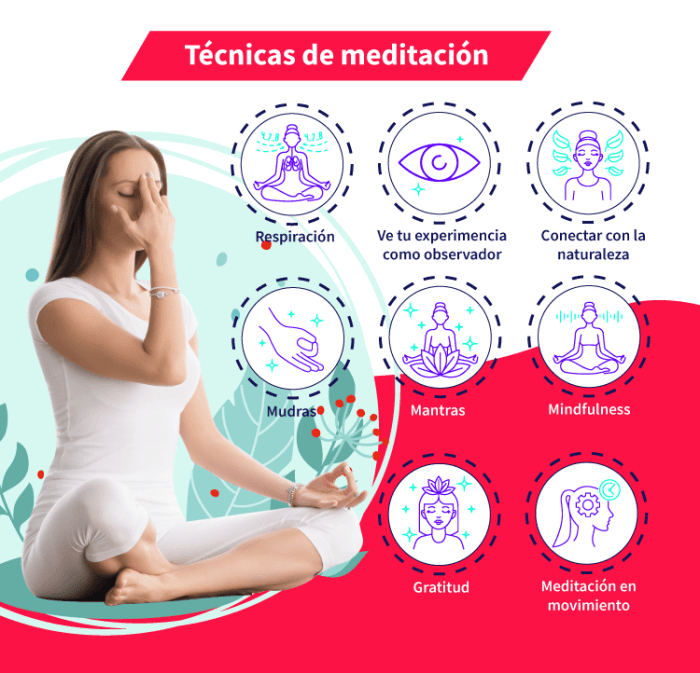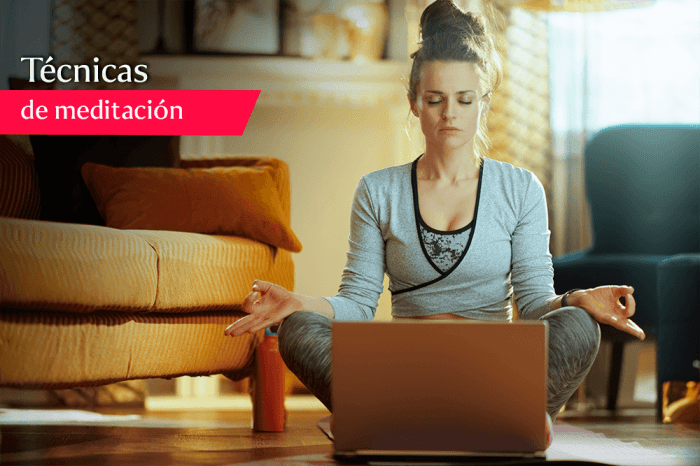With 10 Strategies for Practicing Mindful Meditation at the forefront, embark on a journey towards tranquility and self-discovery. Dive into the world of mindfulness with these transformative techniques that promise a mind-body connection like never before.
Discover the power of mindfulness in everyday life and unlock the secrets to a calmer, more focused mind.
Introduction to Mindful Meditation
Mindful meditation is a practice that involves focusing your mind on the present moment without judgment. It helps you become more aware of your thoughts and feelings, leading to reduced stress, improved focus, and enhanced emotional well-being.
Incorporating mindfulness into daily practice is crucial because it allows you to cultivate a sense of calm and clarity amidst the chaos of everyday life. By taking a few moments each day to be fully present, you can better manage your emotions and respond to challenges with greater resilience.
Benefits of Mindful Meditation
- Reduced stress and anxiety levels
- Improved concentration and focus
- Enhanced self-awareness and emotional regulation
- Increased feelings of gratitude and positivity
Impact on Mental Health
- Mindful meditation has been shown to reduce symptoms of depression and anxiety
- It can help in managing chronic pain and improving sleep quality
- Practicing mindfulness regularly can lead to a greater sense of overall well-being and contentment
Setting Up a Mindful Meditation Space

Creating the perfect environment for mindful meditation is essential to enhance your practice and deepen your focus. Here are some tips on setting up a mindful meditation space that promotes relaxation and minimizes distractions.
Ideal Environment for Mindful Meditation
To create an ideal space for mindful meditation, choose a quiet area in your home where you can have some privacy. This could be a corner of a room, a dedicated meditation space, or even a tranquil outdoor spot if weather permits.
- Avoid high-traffic areas or places with loud noises to ensure a peaceful atmosphere.
- Consider using natural elements like plants, crystals, or essential oils to enhance the calming ambiance.
- Use comfortable cushions or a meditation mat to support your posture and make your practice more enjoyable.
Decor, Lighting, and Ambiance
When it comes to decor, opt for soothing colors like blues, greens, or earth tones to create a sense of tranquility. Soft lighting, such as candles or fairy lights, can help set a relaxing mood for your meditation sessions.
- Keep the space clutter-free to promote a sense of clarity and openness in your mind.
- Play soft instrumental music or nature sounds in the background to aid in relaxation and focus.
- Consider adding personal touches like inspirational quotes, artwork, or spiritual symbols to make the space feel more inviting and meaningful.
Breathing Techniques in Mindful Meditation

Breath awareness plays a crucial role in mindfulness practice as it helps individuals anchor themselves in the present moment and cultivate a sense of calm and focus. By focusing on the breath, practitioners can quiet the mind, reduce stress, and enhance overall well-being.
Different Breathing Techniques
- Deep Breathing: Inhale deeply through the nose, allowing the breath to fill the lungs completely. Exhale slowly through the mouth, releasing any tension or negative energy.
- Counted Breaths: Count each inhale and exhale, focusing on the rhythm and pace of the breath. This technique can help maintain concentration during meditation.
- Alternate Nostril Breathing: Close one nostril with your thumb and inhale through the other nostril. Then switch nostrils and exhale through the opposite side. This technique can help balance energy and promote relaxation.
Focusing on the breath during meditation can improve concentration, reduce anxiety, and enhance self-awareness.
Body Scan Meditation

Body scan meditation is a mindfulness practice that involves systematically focusing on each part of the body, starting from the toes and moving up to the head. The purpose of body scan meditation is to increase awareness of physical sensations, release tension, and cultivate a sense of relaxation and presence in the body.
Process of Body Scan Meditation
- Find a comfortable position either sitting or lying down.
- Close your eyes and bring your attention to your breath, taking a few deep breaths to center yourself.
- Begin to focus on each part of your body, starting with your toes. Notice any sensations without judgment or trying to change anything.
- Slowly move your attention up through your feet, legs, hips, torso, arms, hands, neck, and head, paying attention to any areas of tension or relaxation.
- If your mind wanders, gently bring your focus back to the part of the body you are scanning.
- Finish the body scan by taking a few deep breaths and slowly opening your eyes.
Benefits of Body Scan Meditation
- Helps to release tension and reduce stress by bringing awareness to areas of the body that may be holding tension.
- Increases mindfulness and body awareness, allowing you to better understand your physical sensations and reactions.
- Promotes relaxation and a sense of calm by focusing on the present moment and letting go of worries or distractions.
- Can improve sleep quality by helping to relax the body and mind before bedtime.
Mindfulness of Emotions
When practicing mindful meditation, it’s essential to also focus on mindfulness of emotions. This involves observing and regulating our emotions during meditation to enhance our emotional intelligence.
Techniques for Observing and Regulating Emotions
- Start by acknowledging your emotions without judgment. Simply observe them as they arise during your meditation practice.
- Practice deep breathing techniques to help calm your mind and body when strong emotions surface.
- Label your emotions without getting attached to them. Simply recognize them as passing states of mind.
- Use body scan meditation to bring awareness to how emotions manifest physically in your body.
- Allow yourself to feel and experience your emotions fully without trying to suppress or ignore them.
How Mindfulness of Emotions Enhances Emotional Intelligence
- By observing and regulating emotions during meditation, you can develop a greater sense of self-awareness and emotional control.
- Practicing mindfulness of emotions can help you better understand the root causes of your feelings and reactions.
- Enhanced emotional intelligence through mindfulness can lead to improved communication, empathy, and relationships with others.
- By cultivating a non-reactive mindset towards emotions, you can respond to challenging situations with more clarity and compassion.
Incorporating Mindful Movement: 10 Strategies For Practicing Mindful Meditation
Mindful movement is the practice of combining physical movement with mindfulness techniques to bring attention to the present moment. It involves moving your body in a deliberate and conscious way, focusing on the sensations and feelings that arise during the movement.
Examples of Mindful Movement Exercises
- Walking meditation: Slowly and mindfully walk, paying attention to each step you take, the sensations in your feet, and the movement of your legs.
- Yoga: Engage in a yoga practice that emphasizes breath awareness, body alignment, and mindful movements to cultivate a sense of presence.
- Tai Chi: Practice the slow and flowing movements of Tai Chi while being fully aware of your body’s position, breath, and energy flow.
Benefits of Combining Movement with Mindfulness Practice
- Enhanced body awareness: Mindful movement helps you connect with your body, improve posture, and release tension that you may not have been aware of before.
- Improved focus and concentration: By combining movement with mindfulness, you train your mind to stay present and focused, which can improve your concentration in daily activities.
- Reduced stress and anxiety: Engaging in mindful movement can help calm the mind, reduce stress levels, and alleviate symptoms of anxiety through the combination of physical activity and mindfulness.
Practicing Gratitude and Loving-Kindness
Practicing gratitude and loving-kindness in mindful meditation can significantly enhance your overall well-being and positivity. These practices help cultivate a sense of appreciation, compassion, and connection with yourself and others.
Cultivating Gratitude
- Begin your meditation by reflecting on things you are grateful for in your life.
- Express gratitude for simple things like a beautiful sunrise, a delicious meal, or a kind gesture from someone.
- Focus on the positive aspects of your life and shift your mindset towards gratitude.
Cultivating Loving-Kindness
- Send loving-kindness and compassion to yourself by repeating phrases like “May I be happy, may I be healthy, may I be safe, may I live with ease”.
- Extend loving-kindness to others by visualizing them happy, healthy, and at peace.
- Practice forgiveness and let go of any negative feelings towards yourself or others.
Gratitude turns what we have into enough, and loving-kindness spreads positivity and connection in our lives.
Overcoming Challenges in Mindful Meditation
When it comes to practicing mindful meditation, it’s not always smooth sailing. Distractions, wandering thoughts, and lack of motivation can often get in the way of a peaceful practice. But fear not, there are strategies you can use to overcome these obstacles and stay on track with your meditation journey.
Dealing with Distractions and Wandering Thoughts, 10 Strategies for Practicing Mindful Meditation
One of the most common challenges during meditation is dealing with distractions and wandering thoughts. It’s normal for your mind to wander, but the key is to gently bring your focus back to the present moment without judgment. Here are some strategies to help you stay focused:
- Acknowledge the distraction without getting frustrated.
- Label the thought or feeling and let it pass by.
- Use your breath as an anchor to bring you back to the present.
- Practice self-compassion and patience with yourself.
Staying Consistent and Motivated
Consistency is key when it comes to reaping the benefits of mindful meditation. However, staying motivated can be a challenge, especially when life gets busy. Here are some tips to help you stay consistent and motivated in your meditation practice:
- Schedule your meditation sessions at the same time every day.
- Start with shorter sessions and gradually increase the duration.
- Find a meditation buddy to hold you accountable.
- Remind yourself of the positive impact meditation has on your well-being.
Mindful Eating Meditation

Mindful eating meditation involves being fully present and aware while consuming food, focusing on the sensations, flavors, and textures of each bite. This practice not only helps in cultivating a healthier relationship with food but also promotes overall well-being and mindfulness in daily life.
Benefits of Mindful Eating Meditation
- Enhances appreciation for food: By paying attention to each bite, you can savor the flavors and textures, leading to a greater sense of enjoyment and gratitude for the nourishment.
- Promotes healthy eating habits: Mindful eating meditation can help in recognizing hunger cues, preventing overeating, and making more conscious choices about what and how much to eat.
- Reduces stress and anxiety: By focusing on the present moment during meals, you can reduce feelings of stress and anxiety, leading to a more relaxed eating experience.
- Improves digestion: Eating mindfully allows the body to properly digest food by chewing slowly and fully experiencing the act of eating, which aids in better digestion and nutrient absorption.
Practicing Mindful Eating
- Start by setting aside dedicated meal times free from distractions like phones or screens to focus solely on your food.
- Engage all your senses while eating, noticing the colors, smells, tastes, textures, and sounds of your food.
- Chew each bite slowly and thoroughly, savoring the flavors and being mindful of the act of eating.
- Pause between bites to check in with your body’s hunger and fullness cues, allowing yourself to eat until you are satisfied, not stuffed.
- Practice gratitude for the food on your plate, acknowledging the effort that went into its production and the nourishment it provides your body.
Cultivating a Daily Meditation Routine

Establishing a daily mindful meditation practice is key to reaping the full benefits of this practice. Consistency is crucial in developing a routine that works for you.
Setting Realistic Goals
When starting a daily meditation routine, it’s important to set realistic goals. Begin with short sessions, like 5-10 minutes a day, and gradually increase the duration as you become more comfortable with the practice.
Creating a Sustainable Routine
- A consistent time of day: Choose a specific time each day to meditate, whether it’s in the morning, during a lunch break, or before bed.
- Designate a quiet space: Find a peaceful spot where you won’t be disturbed during your meditation sessions.
- Use reminders: Set alarms or notifications to remind you to meditate daily.
Long-Term Benefits of Consistent Practice
Consistent daily meditation practice can lead to a wide range of benefits, including reduced stress, improved focus and concentration, better emotional regulation, and increased self-awareness. Over time, you may also notice improvements in your overall well-being and mental clarity.
Concluding Remarks
Embrace the path to mindfulness with these 10 strategies and witness the profound impact they can have on your mental and emotional well-being. Begin your mindful meditation journey today and experience the true essence of inner peace and harmony.